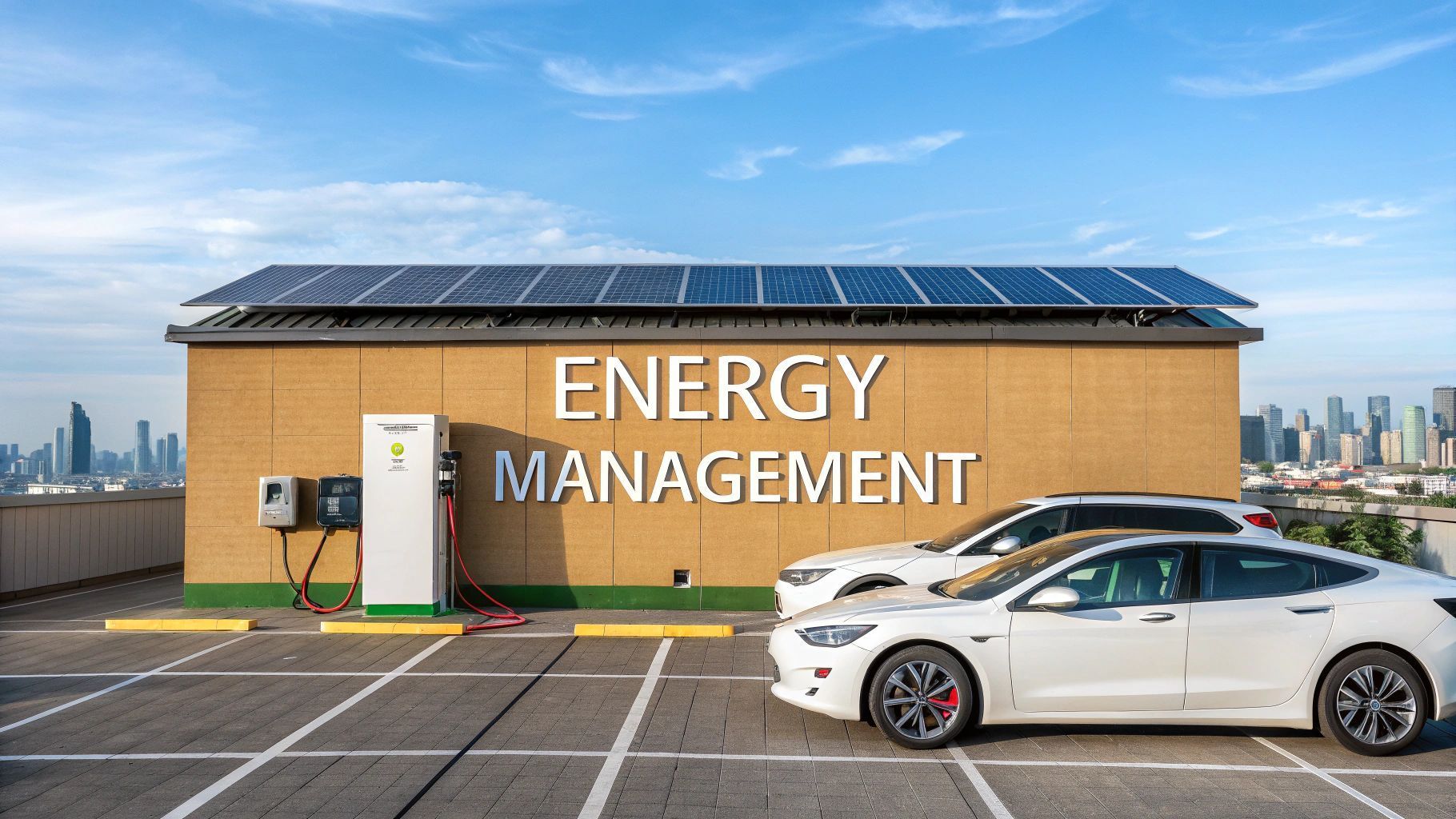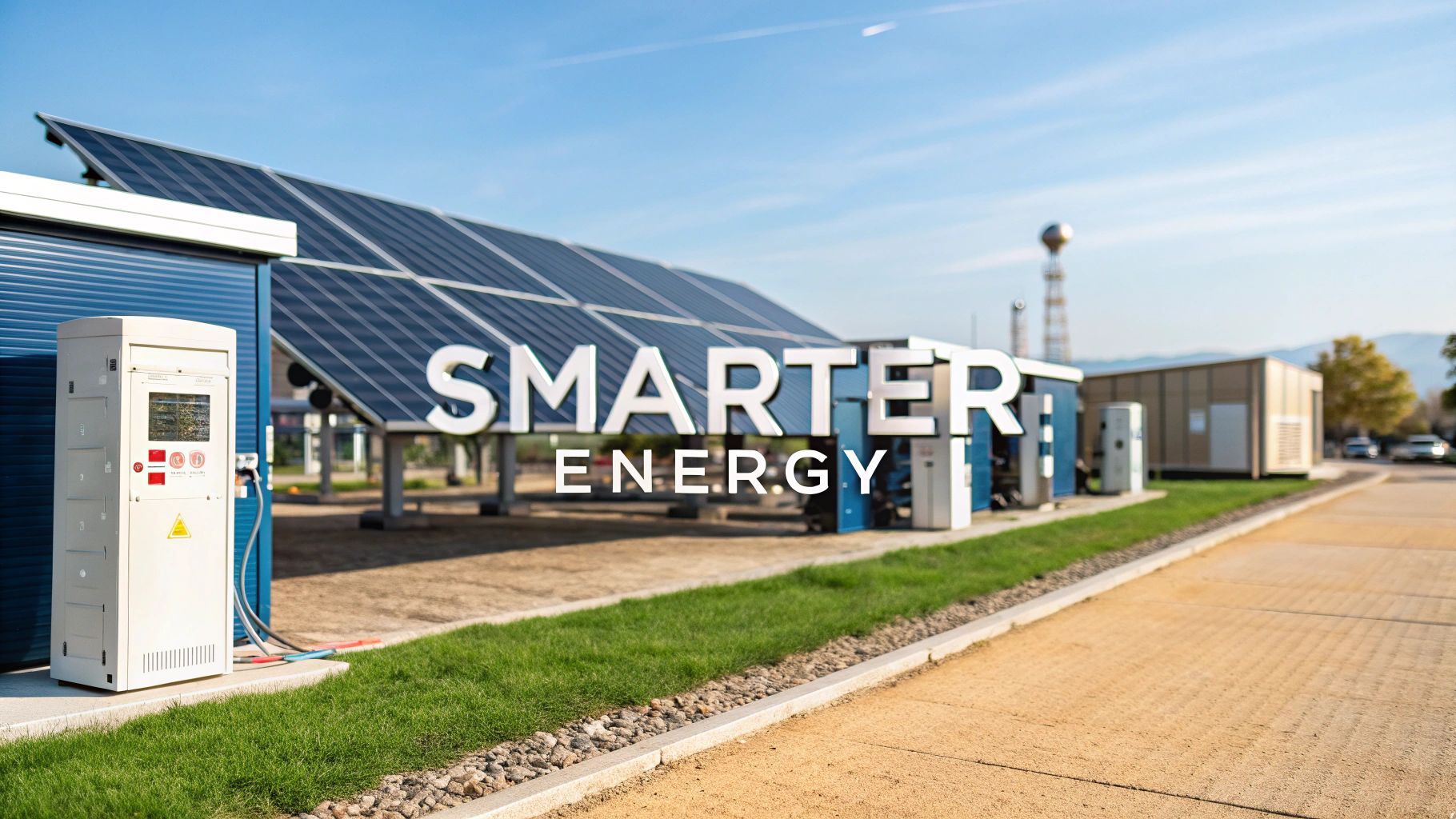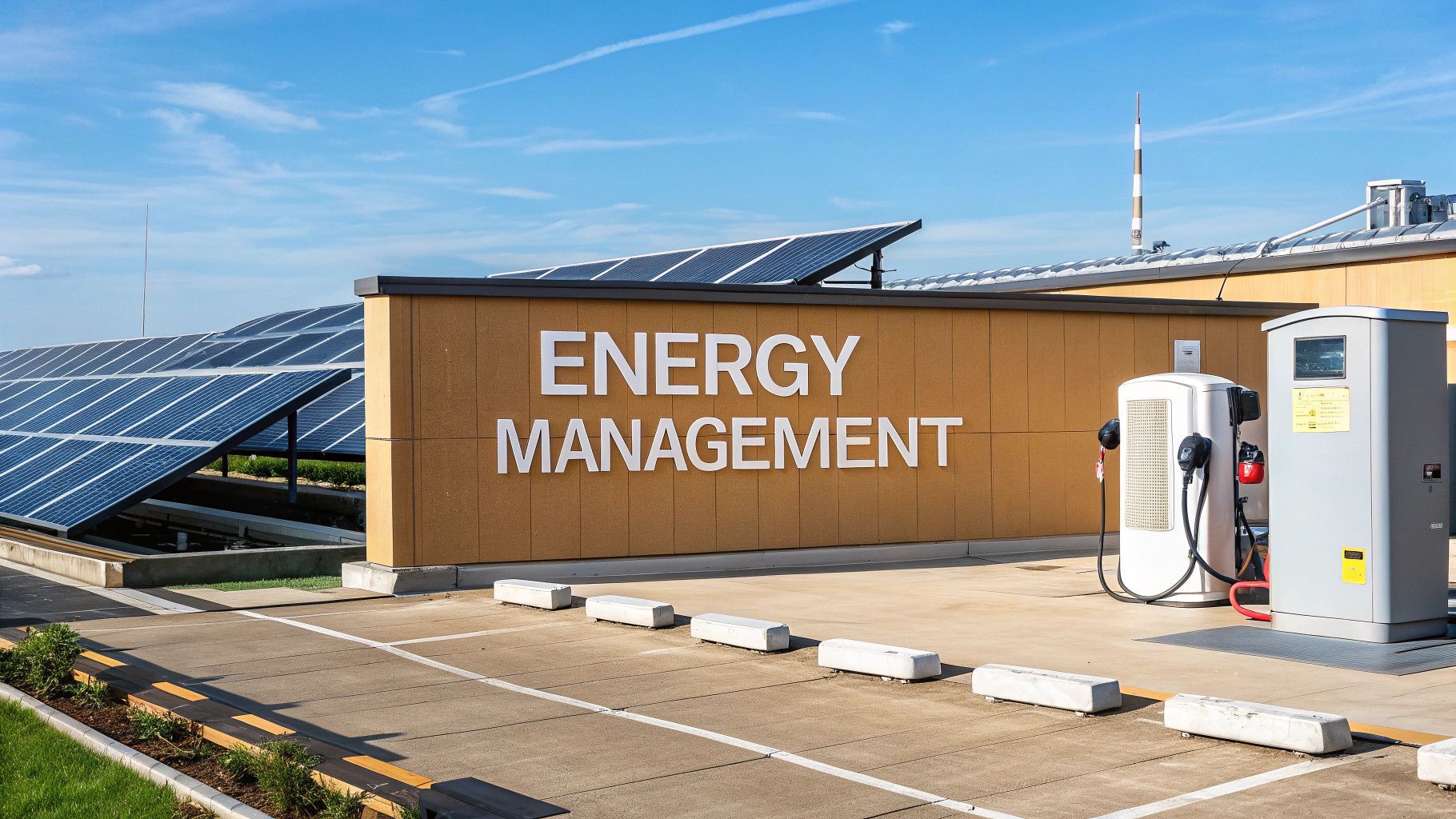Portable Charging Station for Electric Cars: Your Ultimate Guide
Picture this: the ability to roll out rapid EV charging anywhere you need it. A remote fleet depot, a major outdoor festival, the middle of a car park – all without being shackled to the grid. A portable charging station for electric cars isn't just a glorified emergency backup; it's a serious, mobile power source that can deliver a significant charge, fast. This is the technology that's making EV charging flexible and accessible in ways we couldn't imagine just a few years ago.
The Freedom to Power EVs Anywhere
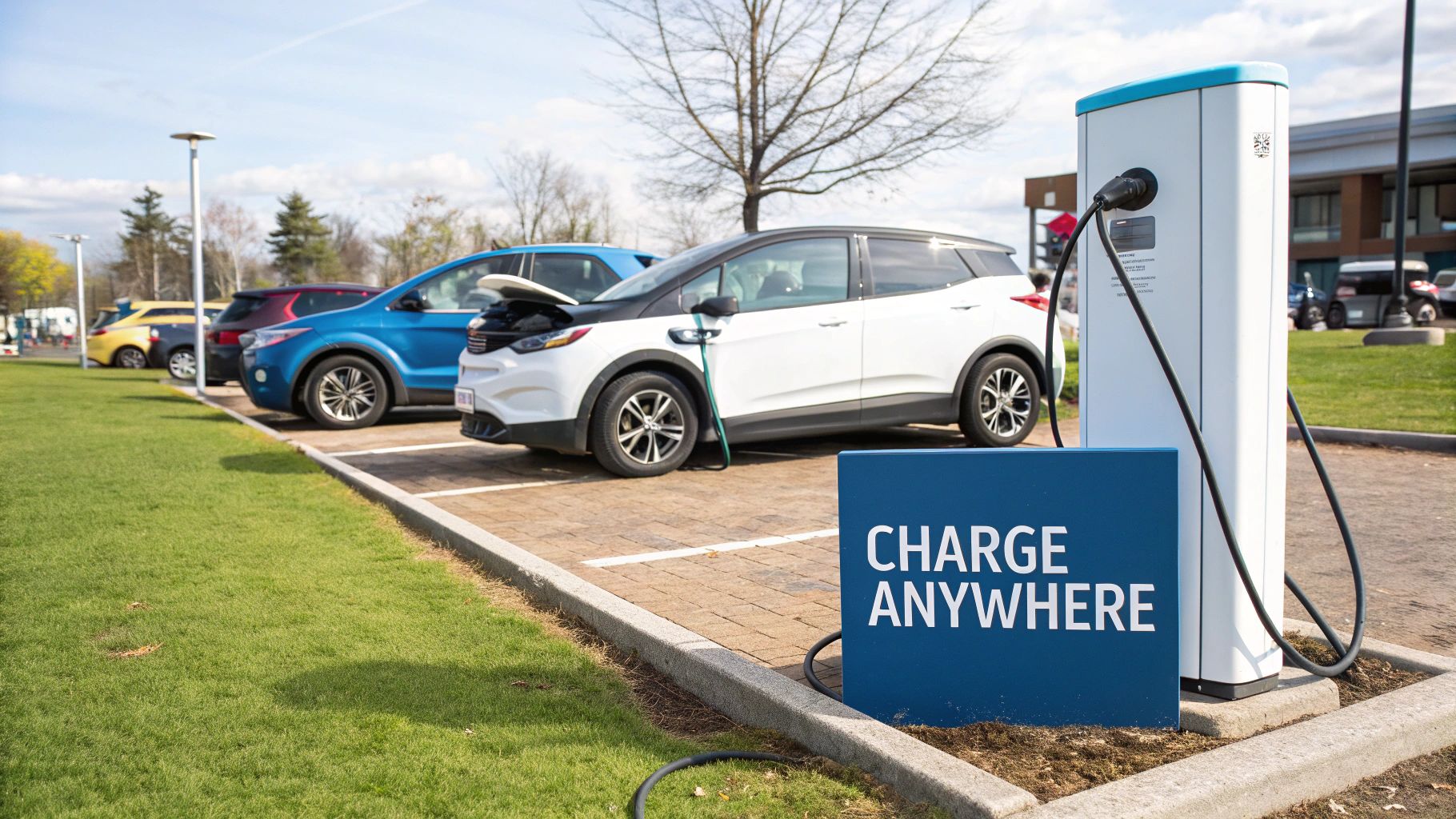
This guide is all about the real-world power of mobile EV charging. We're not talking about small consumer gadgets you keep in your boot for a top-up. We're focusing on the commercial-scale solutions designed to tackle the big hurdles holding back EV adoption for businesses and fleets – things like range anxiety and the eye-watering cost of grid upgrades from constrained grid connections.
Think of these units as sophisticated, high-capacity batteries on wheels. They are a key piece of a much larger, distributed energy ecosystem, built to support a massive range of applications from EV charging and batteries to grid-scale batteries.
More Than Just an Emergency Charger
Forget the small, slow chargers. A commercial portable charging station delivers genuine mobile EV charging infrastructure. These systems are engineered from the ground up to provide rapid EV charging speeds, adding substantial range in minutes, not hours.
This capability makes them an absolute game-changer for businesses where vehicle downtime is simply not an option. They solve problems where grid connections are too weak or expensive to upgrade. We see them being used in all sorts of clever ways:
- Fleet Depots: Providing dependable overnight charging without needing to dig up the road for new grid connections.
- Events and Venues: Offering temporary charging for visitors without the commitment of permanent installations.
- Roadside Assistance: Giving stranded drivers a meaningful charge to get them safely on their way.
- Grid Support: Acting as powerful batteries to help stabilise local power networks during peak demand.
The real magic is decoupling charging from a fixed spot on a map. You bring the power to the vehicle, giving any organisation moving to an electric fleet a level of flexibility and resilience that was previously impossible.
Integrating with a Modern Energy System
A core idea we'll keep coming back to is how these mobile chargers fit into the bigger energy picture. They aren't just isolated bits of kit. They are designed to work in harmony with other systems, especially combined on-site renewables like solar panels.
By capturing and storing surplus green energy generated during the day, they can create a completely self-sufficient charging cycle. This synergy doesn't just help organisations meet their sustainability targets; it gives them true energy independence. To see how this is already reshaping the industry, you can learn more about the rise of ZPN's mobile charging units and their permanent impact. It’s a perfect example of how mobile solutions are building a smarter, more resilient and decarbonised future for transport.
How a Portable EV Charging Station Works
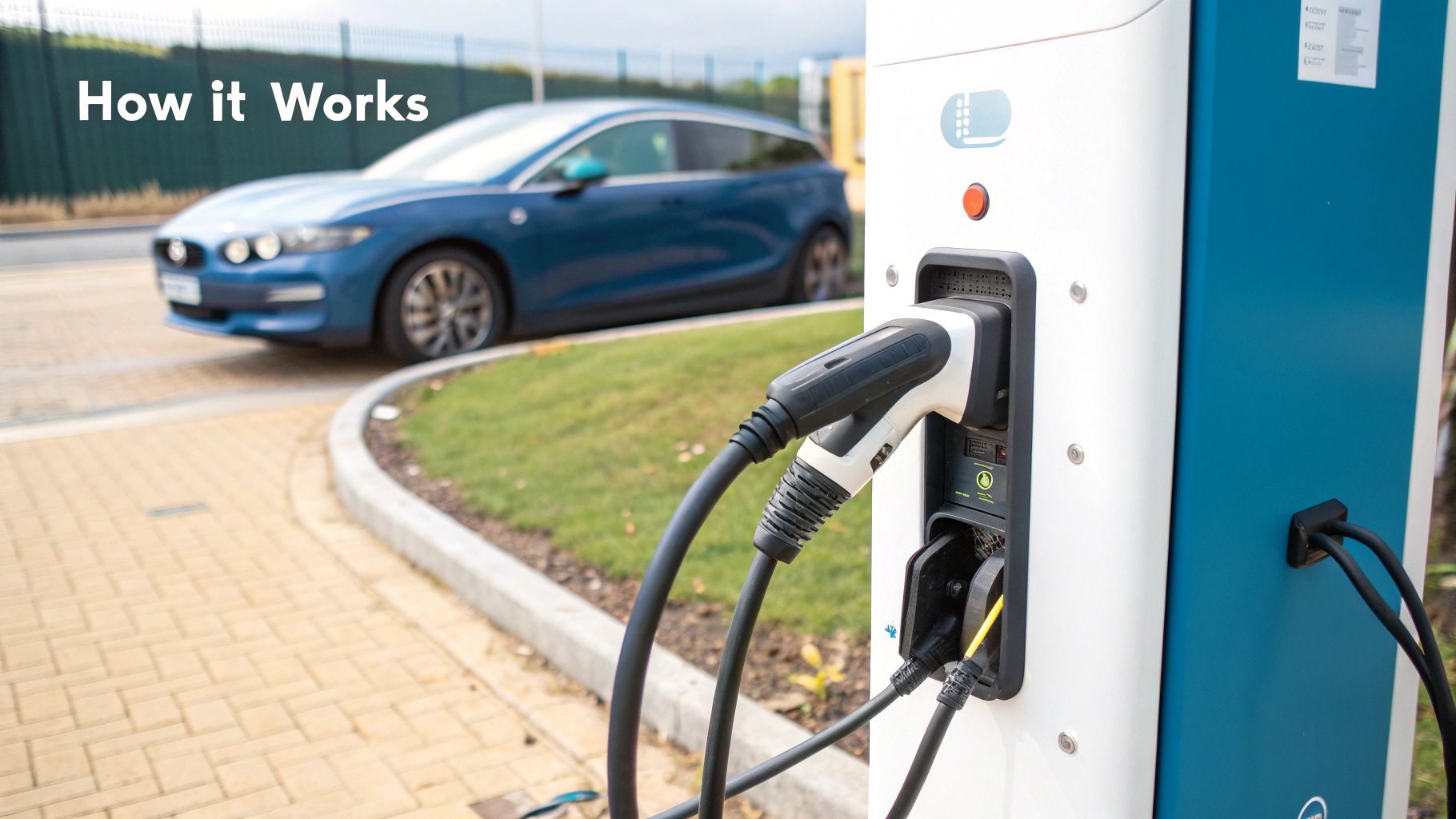
To really get your head around how a portable charging station for electric cars works, it’s best to forget the idea of a simple power bank. These aren’t little gadgets for a quick top-up. Think bigger. Think of them as sophisticated, mobile energy reservoirs—serious commercial kit designed to deliver a huge amount of power wherever it's needed.
At their heart, these stations are built on three key pillars. First, a high-capacity lithium-ion battery that acts as the energy store. Next, a powerful inverter that converts the stored direct current (DC) from the battery into the high-power AC or DC an electric vehicle needs to charge. And finally, the user-facing charging interface, complete with industry-standard connectors like CCS, making it compatible with almost any EV on the road today.
The Reservoir Analogy Explained
Imagine a massive reservoir slowly collecting water from a small, steady stream. That stream represents a standard, low-power grid connection—maybe a simple 13-amp plug in a depot or a feed from some solar panels on the roof. It takes its time, gently filling the reservoir over many hours without putting any real strain on the source.
That's precisely the principle behind a portable charging station. It trickle-charges its internal grid-scale batteries from whatever low-power source is available, quietly storing up a massive reserve of energy.
Then, when an EV pulls up needing a quick boost, the floodgates open. The station unleashes all that stored energy in a powerful, controlled surge, delivering a rapid EV charging experience that can add serious range in just a few minutes. This clever bit of engineering lets businesses offer high-speed charging without the eye-watering cost and disruption of a major grid upgrade.
Delivering Power Beyond the Grid
This ability to store and then rapidly deploy energy is what sets commercial-grade units apart from consumer gadgets. A proper portable station provides true mobile EV charging , capable of supporting an entire fleet of vans or powering a public event. This flexibility is becoming absolutely essential as the UK's charging infrastructure scrambles to keep up with demand.
The national network is certainly growing. As of September, there were over 86,000 public charging devices across the UK. That’s an impressive jump of nearly 30% in just one year , which shows you just how fast EV adoption is moving. While fixed charge points are the backbone of the system, mobile solutions are the ones filling in the gaps, bringing power to places where the grid is weak or where temporary demand simply overwhelms the local supply.
The Technology Powering Mobile Charging
The real magic happens inside, where all the components work in harmony. The Battery Management System (BMS) is the brain of the whole operation, carefully monitoring the lithium-ion cells to make sure they charge and discharge safely and efficiently, squeezing every last drop of performance and life out of them. A solid grasp of the underlying battery and charging technologies is what separates a good unit from a great one.
The choice of battery technology has a direct impact on everything—the station’s capacity, its weight and how fast it can charge a vehicle. For a deeper dive into how these systems are engineered, our article on the vital role of a battery pack for car charging is well worth a read. It unpacks how these integrated systems are becoming central to the future of distributed energy.
A portable station essentially acts as a buffer between the grid and the vehicle. It absorbs energy slowly and delivers it quickly, turning a low-power connection into a high-power charging asset.
This approach is the cornerstone of flexible, intelligent charging. It allows organisations to jump into electrification without being held back by their existing infrastructure, paving the way for a much more adaptable and resilient energy future.
Mobile EV Charging in the Real World
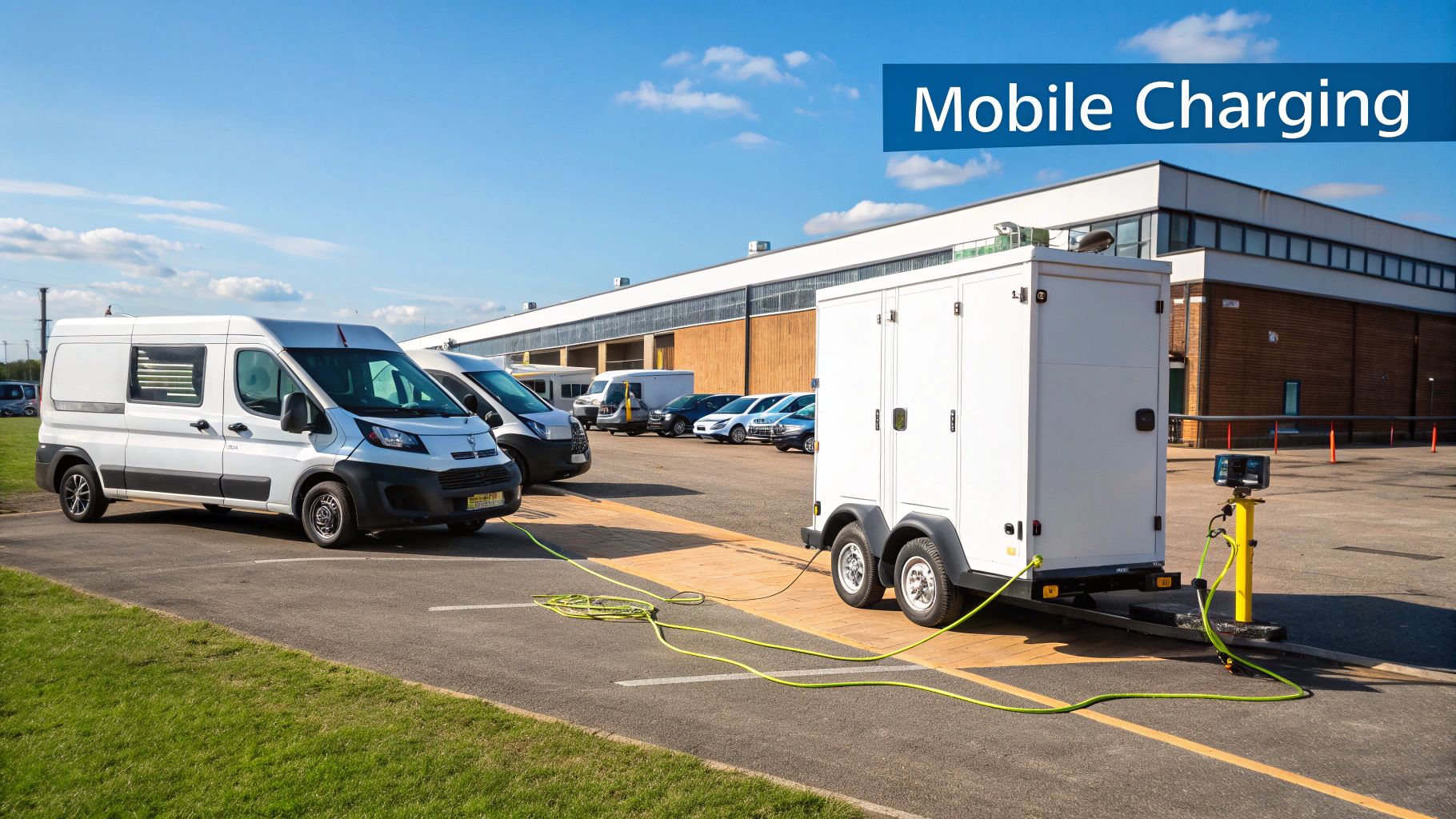
This is where the theory hits the road. A portable charging station for electric cars really shows its worth when you see it solving genuine, everyday problems. These units are already proving invaluable across all sorts of commercial and public settings, acting as a flexible power source that brings rapid EV charging to places where permanent infrastructure just isn't feasible.
From busy fleet depots to remote construction sites, the applications are as varied as they are vital. These mobile powerhouses aren't just a nice-to-have; they are a critical tool for businesses making the switch to electric and for event organisers who need power on demand.
Supporting Fleets with Grid Constraints
One of the best uses for a portable charger is inside a commercial fleet depot. A lot of depots, especially older ones, are stuck with constrained grid connections . They simply cannot handle a bank of fixed rapid chargers without eye-wateringly expensive and slow infrastructure upgrades. For many businesses, this is a huge barrier to going electric.
A portable charging station neatly sidesteps this problem. The unit can be trickle-charged overnight from a standard, low-power supply. It then stores this energy in its internal grid-scale batteries and unleashes it for rapid charging during the day. This keeps vehicles topped up and ready for their next shift without ever overwhelming the local grid.
To see how these solutions are already making a difference, you can explore several case studies that prove ZPN delivers where others don't.
Powering Events and Temporary Venues
Installing permanent chargers for a one-off event makes absolutely no sense. A portable charging station for electric cars is the perfect answer for:
- Music Festivals and Outdoor Events: Give staff, vendors and attendees convenient charging without digging up the fields for permanent cables.
- Construction Sites: Power up electric vans and machinery in off-grid or remote locations, helping to make construction practices greener.
- Corporate Events and Pop-ups: Offer a premium service for guests while showing a real commitment to sustainability.
In any of these situations, the station can be dropped off, run for the event's duration and then taken away. It's a completely flexible power solution.
For event organisers, mobile charging is a game-changer. It allows them to meet the growing demand for EV facilities without investing in permanent infrastructure that would sit unused for most of the year.
Enhancing Roadside Assistance and Busting Queues
The impact of mobile EV charging is felt directly by drivers out on the road. For roadside assistance crews, a van-mounted or trailer-based portable charger is an essential piece of kit. It can give a stranded EV driver just enough juice to get to the next service station, turning a potential recovery job into a simple top-up.
Another clever use is for 'charge queuing' at busy motorway services. During peak times like bank holidays, the queues for fixed chargers can be maddening. Rolling out a few portable units can instantly add capacity, slash waiting times and keep traffic flowing. It makes long-distance EV travel that much smoother.
The demand for this kind of flexible infrastructure is undeniable. In the first quarter of the year alone, UK drivers plugged in for over 7.6 million public charging sessions. The rapid and ultra-rapid segment—the ones you need for quick top-ups—now accounts for about 60% of the UK's public capacity, with hundreds of new high-speed units being added every month. You can discover more insights about these 2025 EV market statistics to see just how quickly the landscape is changing.
Overcoming Grid Constraints with Mobile Power
One of the biggest wins for a portable charging station for electric cars is its ability to completely bypass the limits of the existing electrical grid. This is a massive and often costly headache for businesses, especially those on commercial depots, rural sites or older industrial estates where the grid connection just doesn't have the oomph for multiple rapid chargers.
The traditional path? A long, expensive grid upgrade project. We're talking digging up roads, laying new cables and navigating a maze of planning permissions that can drag on for months, sometimes even years. For any business trying to electrify its fleet at pace, this kind of delay is a serious operational roadblock. A mobile charging station just flips that whole equation on its head.
The Power of Peak Shaving
Think of a portable charging station as a large, intelligent battery that creates a buffer between a weak grid connection and the heavy power demands of rapid EV charging . The idea is brilliantly simple. The unit slowly trickle-charges from whatever limited grid supply is available, usually during off-peak hours when electricity is cheapest.
This stored energy is then ready to unleash at high speed whenever a vehicle pulls up to charge. This process, known as 'peak shaving' , lets a business offer genuine fast charging during its busiest hours without ever pulling a huge spike of power from the grid all at once. The result? You avoid those punitive demand charges from energy suppliers that can add thousands to your electricity bill.
By banking cheap, off-peak energy and delivering it on demand, a portable station turns a low-power grid connection into a high-value asset for mobile EV charging and operational efficiency.
The infographic below really brings this to life, showing how a portable station uses stored energy to deliver rapid charging and generate serious savings.
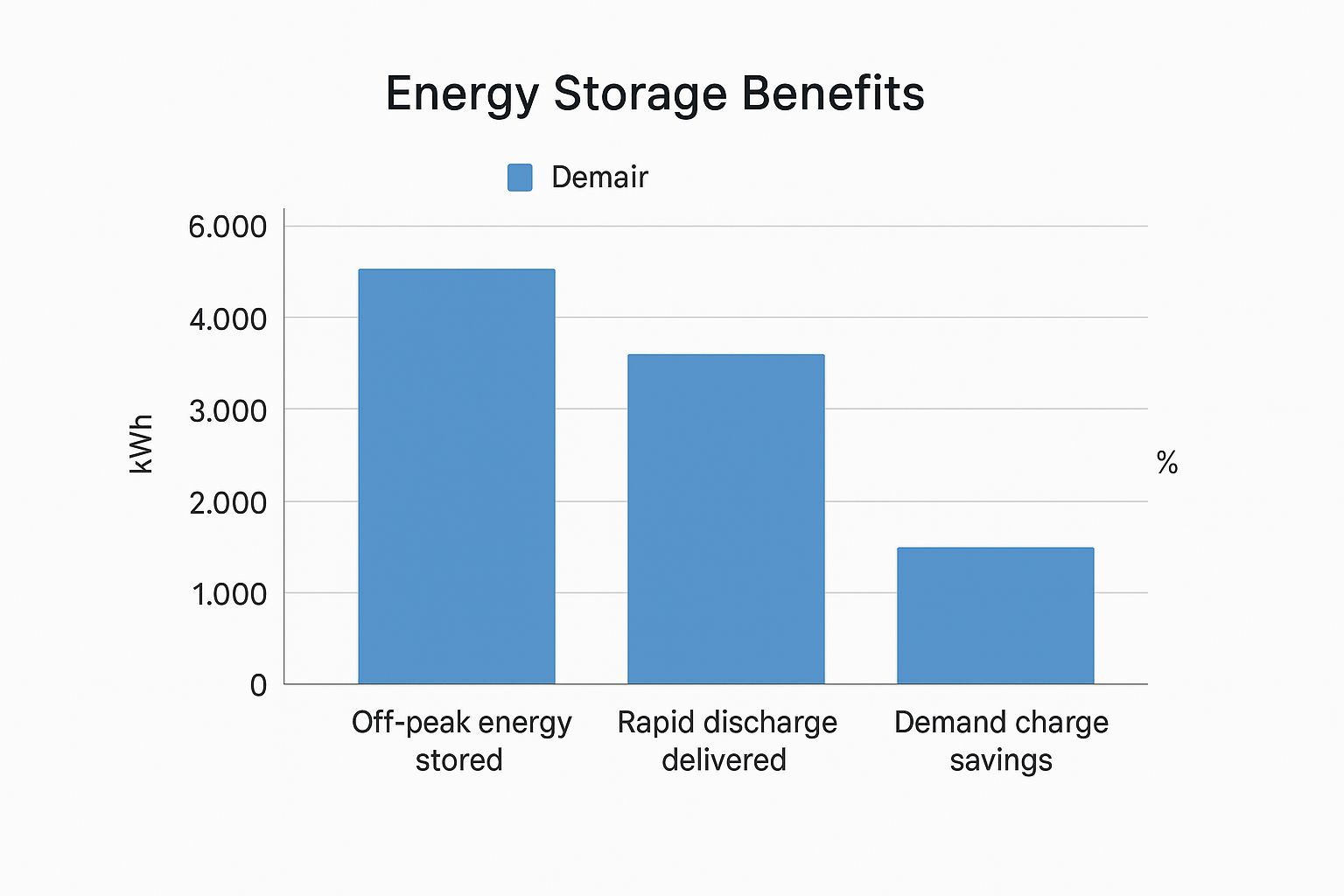
You can clearly see how the energy delivered for charging massively outweighs the slow, steady power intake. It's a perfect illustration of the system's ability to amplify a constrained grid connection while slashing costly peak demand.
Deploying portable charging is often a far smarter move than committing to a full-scale grid upgrade. Let's look at a quick comparison of what that really means in terms of time and money.
Grid Upgrade vs Portable Charging A Cost and Time Comparison
| Factor | Traditional Grid Upgrade | Portable Charging Station |
|---|---|---|
| Upfront Cost | £50,000 - £1,000,000+ . Can be prohibitively expensive due to civil works. | £30,000 - £200,000+ . A known capital cost with no hidden extras. |
| Timeline | 6 months to 2+ years . Long lead times for planning, permissions and construction. | Weeks . Can be deployed almost immediately once delivered to site. |
| Flexibility | Fixed and permanent . Once built, the infrastructure is locked in place. | Highly flexible . Can be moved to different sites or depots as needs change. |
| Disruption | High . Involves significant digging, road closures and operational downtime. | Minimal . No civil engineering required; simply position and connect. |
As the table shows, a portable charging station offers a significantly faster, more cost-effective and adaptable route to rapid EV charging, avoiding the huge investment and operational paralysis that can come with a major grid upgrade.
Enhancing Energy Resilience and Independence
Beyond the cost savings, these systems add a vital layer of energy resilience. They aren't just for charging cars; they can also act as a backup power source. If a grid outage hits, a fully charged portable station can keep essential operations running, ensuring your fleet vehicles stay charged and ready to go.
This capability is a game-changer for businesses that depend on their vehicles for critical services. It turns your charging infrastructure into a dual-purpose asset, covering both transport energy and business continuity.
Better still, by pairing a portable charging station with on-site renewables like solar panels, businesses can create a genuinely self-sufficient energy ecosystem. This integration of EV charging, battery storage and local generation unlocks several key advantages:
- Maximised Self-Consumption: Store excess solar energy that would otherwise be sold back to the grid for pennies and use it later for free EV charging.
- Reduced Grid Reliance: Become less dependent on grid electricity, shielding your business from price spikes and supply disruptions.
- Decarbonised Transport: Power your fleet with 100% renewable energy generated on-site—a powerful proof point for any company's sustainability goals.
This strategic approach to energy management is central to modernising commercial operations. A portable charging station for electric cars is so much more than a charger; it’s a cornerstone of a flexible, resilient and cost-effective energy system that supports businesses today and gets them ready for whatever comes next.
Pairing Portable Chargers with Renewable Energy
The true power of a portable charging station for electric cars isn't just its mobility; it's how it can become the heart of a self-sufficient energy ecosystem. When you combine these mobile batteries with on-site renewables like solar panels, you’re no longer just charging cars. You're building a powerful, closed-loop system for genuinely clean transport.
Think of these stations as the missing link between generating clean energy and actually using it. They capture and store all the excess electricity your solar panels produce on a sunny day—energy that might otherwise be sold back to the grid for pennies or wasted entirely. That stored green energy is then ready to be deployed for rapid EV charging whenever you need it, day or night.
This creates a truly decarbonised transport solution, fuelled directly by the power you generate on-site. The portable charger is transformed into a key distributed energy resource (DER) , giving your local microgrid the two things it needs most: storage and flexibility.
Creating a Local Energy Microgrid
Pairing a portable charging station with solar panels effectively creates your own small, independent power network. This setup does more than just boost your energy independence; it can dramatically cut long-term running costs for any business serious about hitting its sustainability targets.
Picture a commercial depot with a huge roof covered in solar panels. During the day, those panels are generating far more power than the building itself needs. Instead of letting that surplus trickle back to the grid for a pittance, it’s all funnelled directly into a portable charging station.
The station’s grid-scale batteries act as a reservoir, holding onto that clean solar power. When the fleet returns in the evening, the vehicles plug in and recharge using the stored solar energy, completely bypassing the grid and its expensive peak-time tariffs.
This synergy transforms a business from a passive energy consumer into an active energy manager. The portable charging station becomes the heart of a system that generates, stores and uses its own clean electricity.
In an era of volatile energy prices and an increasingly fragile grid, this level of control and self-sufficiency is a massive advantage.
Enhancing Charging Accessibility
This distributed energy model also helps tackle bigger infrastructure headaches. The UK’s public charging network is growing but the coverage is wildly inconsistent from one region to the next, which directly impacts how practical on-the-go charging really is.
For example, Greater London is miles ahead, with 25,502 public charging devices as of July—that's over 30% of the entire UK network. Its density of 263 chargers per 100,000 people is more than double the national average of 113. Compare that to Northern Ireland, which has just 35 chargers per 100,000 people .
These numbers paint a clear picture: cities are well-served but rural and remote areas are often left behind. By creating local charging hubs powered by renewables, businesses can fill these critical gaps and guarantee reliable mobile EV charging access, no matter how good (or bad) the local grid connection is. You can discover more about these EV charging statistics to see just how stark the regional differences are.
This approach doesn't just benefit the business; it helps build a more resilient and equitable national charging network. It's proof that with the right technology, clean and reliable EV charging can be delivered absolutely anywhere.
How to Choose the Right Portable Charging Solution
Picking the right portable charging station for your EVs isn’t about finding the single “best” unit on the market. It’s about finding the one that fits your operation like a glove.
Whether you’re managing a commercial fleet, running an event or just need to sidestep a weak grid connection, a little bit of homework goes a long way. This is your practical guide to getting it right.
First things first: you need to know how much power you’ll actually need. The two specs that matter most are battery capacity and power output. These numbers will tell you how many vehicles you can charge and just how fast you can get them back on the road.
Get a Grip on Battery Capacity and Charging Speed
Start with the unit’s battery capacity , which is measured in kilowatt-hours (kWh). This is simply how much energy the station can hold. A bigger capacity, say 200 kWh , means you can service more vehicles before the charger itself needs a top-up. Think of it as the size of a fuel tank—the bigger it is, the further you can go.
Next up is charging speed , or power output, measured in kilowatts (kW). This is all about how quickly that stored energy can be pushed into a vehicle’s battery. The difference can be huge:
- Rapid Charging (50 kW): This is a pretty common speed that can give a vehicle around 100 miles of range in about 35-40 minutes . It’s a great fit for depot top-ups or anywhere vehicles will be parked for a reasonable amount of time.
- Ultra-Rapid Charging (150 kW+): Now we’re talking serious speed. These chargers can deliver that same 100 miles of range in as little as 10-15 minutes . This is what you need for high-turnover spots like public hubs or for emergency roadside assistance where every minute counts.
Finding the right balance here is key. A massive battery paired with an ultra-rapid output is perfect for the most demanding jobs. But for something like overnight fleet charging, a smaller capacity with a standard rapid charger might be all you need.
Think About Footprint and Portability
The word ‘portable’ can mean a lot of different things. When you're looking at a portable charging station for electric cars , you have to consider its physical size and how you plan on moving it around.
Some systems are compact enough to be mounted in a van, ready for quick deployment. Others are much larger, built onto trailers or housed in shipping containers. A trailer-based system is brilliant for moving between different sites, whereas a containerised unit can act as a semi-permanent solution for a depot with a poor grid connection. It all comes down to your business model—do you need to be on the move every day or do you just need an asset you can relocate when needed?
Don't Forget Connectors and Software Smarts
Finally, you need to sweat the small stuff—the connectors and the software. The charger has to have the right plugs for your vehicles. Here in the UK and across Europe, the Combined Charging System (CCS) is the standard for virtually all modern EVs. Some units might also include a CHAdeMO connector, which is handy for supporting older models like the Nissan Leaf.
But the physical plugs are only half the story. The software is what makes a battery truly intelligent. A good Battery Management System (BMS) is non-negotiable; it’s essential for keeping the battery healthy and performing at its best. You'll also want a simple interface for your team and drivers, plus back-end analytics to track energy use and savings. These features are what allow the charger to become a true part of your business operations and your wider energy strategy.
Got Questions? We Have Answers
As portable charging stations for electric cars become a more common sight, it's only natural to have a few questions. How fast are they really? Where do they get their power from? Will they work with my fleet?
Let's clear things up. Here are some straightforward answers to the most common queries we hear.
How Quickly Can a Portable Station Charge an EV?
The real question here is about power output, which we measure in kilowatts (kW). Commercial-grade portable chargers are built for speed, typically delivering anywhere from 50kW up to and beyond 150kW .
So, what does that mean for your drivers?
- A 50kW unit can top up a standard EV with around 100 miles of range in roughly 30-40 minutes.
- An ultra-rapid 150kW station could slash that time, adding the same 100 miles in as little as 10-15 minutes, depending on the car’s battery.
These aren't slow trickle chargers; they deliver speeds comparable to many fixed public charging hubs, making them perfect for getting vehicles back on the road fast.
How Does the Portable Charging Station Itself Get Recharged?
This is where their flexibility really shines. These units aren't tied to a single power source and can be recharged in several ways, adapting to whatever infrastructure you have available.
The most common method is plugging into a standard grid supply. This is a game-changer for businesses with constrained grid connections . You can slowly trickle-charge the station overnight using cheaper, off-peak electricity without overloading your local network.
These systems excel at being powered from diverse sources. They can connect directly to on-site renewables like solar arrays to store 100% green energy or be transported to a high-power grid connection for a fast recharge before being redeployed elsewhere.
Are These Chargers Compatible With All Electric Vehicles?
Absolutely. Commercial portable charging stations are designed to be universal. They come equipped with the industry-standard connectors you'll find across the UK and Europe, so they can serve just about any electric car or van.
The main plug is the Combined Charging System (CCS) , which is used by the vast majority of modern EVs from manufacturers like Tesla, VW and Ford. To ensure total coverage, many units also include a CHAdeMO connector for vehicles like the Nissan Leaf. This guarantees that no matter what vehicles are in your fleet, a portable station has you covered.
At ZPN Energy , we design and build advanced energy solutions that deliver power and flexibility where you need it most. Discover how our integrated systems, from mobile charging units to grid-scale batteries, can support your transition to a cleaner, more resilient energy future. Learn more at https://www.zpnenergy.com.


